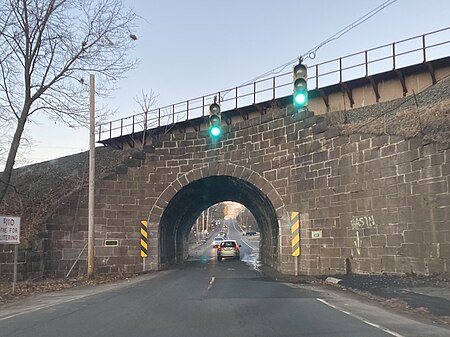Yalesville Underpass
1838 establishments in ConnecticutArch bridges in the United StatesBridges completed in 1838Bridges in New Haven County, ConnecticutBuildings and structures in Wallingford, Connecticut ... and 4 more
Connecticut building and structure stubsConnecticut transportation stubsNortheastern United States bridge (structure) stubsTourist attractions in New Haven County, Connecticut

The Yalesville Underpass is a 30-degree skew arch bridge carrying the railroad over Route 150 and Route 71 in Wallingford, Connecticut. Built in 1838 for the Hartford and New Haven Railroad by William MacKenzie, it is reported to be the first skew underpass in America. The arch was designed to allowed tall hay wagons to pass through but it is not wide enough for modern two-way traffic, the one-way traffic being controlled by a pair of lights. Due to the age of the bridge, it has to undergo repairs on a regular basis.In 2018, work was done to accommodate for an additional train track.
Excerpt from the Wikipedia article Yalesville Underpass (License: CC BY-SA 3.0, Authors, Images).Yalesville Underpass
South Broad Street,
Geographical coordinates (GPS) Address Nearby Places Show on map
Geographical coordinates (GPS)
| Latitude | Longitude |
|---|---|
| N 41.4977 ° | E -72.8144 ° |
Address
South Broad Street
South Broad Street
06450
Connecticut, United States
Open on Google Maps







